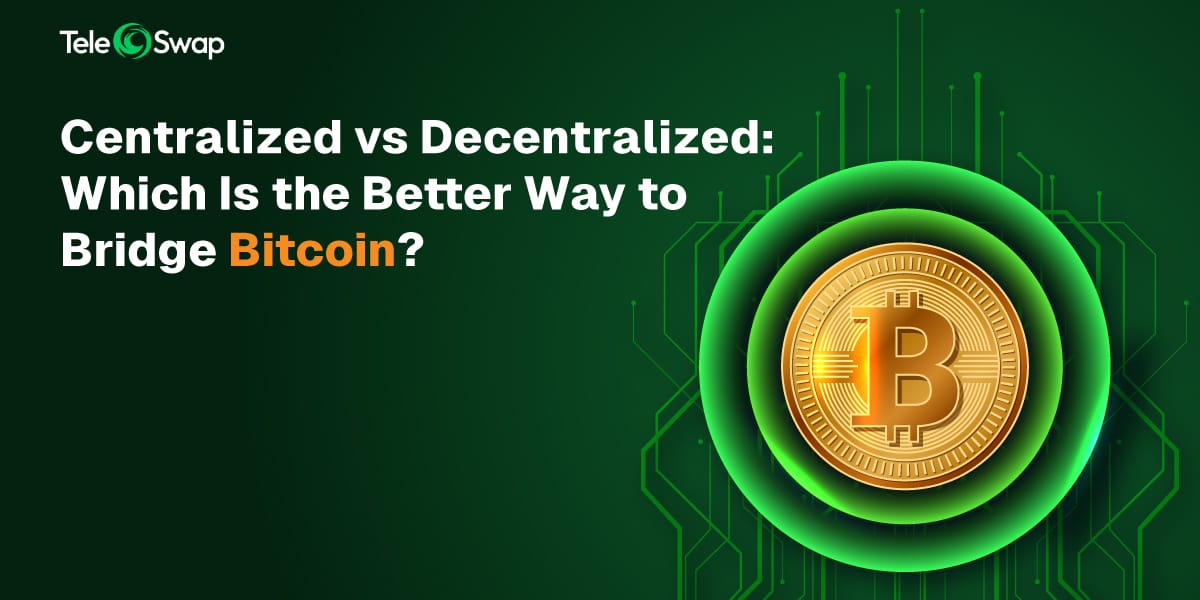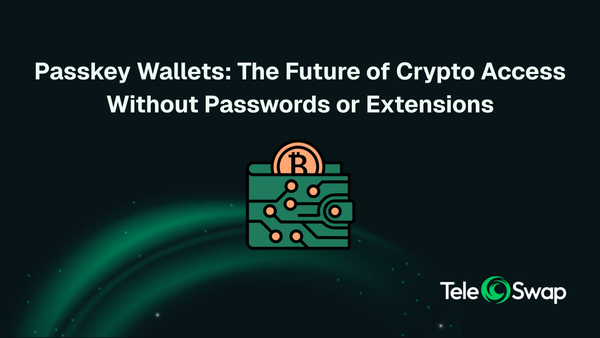Centralized vs Decentralized: Which Is the Better Way to Bridge Bitcoin?

Introduction
Bitcoin’s growing role in the multi-chain world means users often need to bridge BTC to ETH or other networks, and bring it back. Bridging Bitcoin refers to moving value between the Bitcoin blockchain and other platforms (like Ethereum) so that BTC can be used in new places and vice versa. There are two main approaches: using centralized custodians or exchanges (CEXs), and using decentralized, non-custodial protocols (DeFi bridges). Both methods ultimately let you convert between BTC and assets like WBTC (Wrapped BTC on Ethereum), but they differ greatly in trust, speed, cost, and safety. This post compares custodial vs. decentralized Bitcoin bridges – using real examples like Binance (a CEX) and TeleSwap (a DeFi protocol) – to determine which approach is better for bridging BTC in 2025.
What Does It Mean to Bridge Bitcoin? (BTC To ETH, WBTC to BTC)
Bridging Bitcoin means transferring BTC’s value from its native blockchain to another chain (and back). Because blockchains are separate networks, direct transfers aren’t possible without an intermediary system. Instead, bridges “wrap” or swap the asset across chains. For example, to move BTC onto Ethereum, a common method is the “lock-and-mint” model: you send BTC to a bridge address (locking it on Bitcoin), and an equivalent token (like WBTC) is minted on Ethereum to represent that BTC. WBTC (Wrapped BTC) is an ERC-20 token backed 1:1 by real BTC. Later, if you want to go back to Bitcoin, the process reverses – the WBTC on Ethereum is burned (destroyed), and the corresponding BTC is released (unlocked) to your Bitcoin address. In this way, WBTC allows BTC to “speak” Ethereum’s language and interact with Ethereum dApps while still being redeemable for actual Bitcoin
Bridging assets often involves “wrapping” one asset to represent it on another chain, analogous to changing a car’s license plate when crossing into a new The original asset (e.g. BTC) is locked, and a token on the destination chain (e.g. WBTC on Ethereum) is issued to mirror its value.
Importantly, bridging works in both directions. You can convert native BTC to WBTC, using a bridge to get an ERC-20 token for use on Ethereum. You can also convert WBTC back to BTC by redeeming the token for real Bitcoin (burning the WBTC and unlocking BTC). Likewise, users often want to bridge BTC to ETH (essentially obtaining ETH or Ethereum-based assets in exchange for BTC) or do the reverse, bridge ETH to BTC (convert Ether or tokens into actual Bitcoin on the BTC network). In practice, these conversions can be done via centralized exchanges or via specialized cross-chain protocols. The end goal is the same – moving value between Bitcoin and Ethereum – but the path taken can be very different depending on a centralized vs decentralized approach.
Centralized Bitcoin Bridging (CEXs and Custodial Wraps)
Centralized bridging relies on trusted middlemen – typically exchanges or custodial platforms – to move BTC across chains. A prime example is using a major exchange like Binance to swap and transfer assets. If Alice has BTC but needs ETH, she can send her BTC to Binance, trade BTC for ETH on the exchange, then withdraw the ETH to her own Ethereum wallet. Similarly, to get a Bitcoin-backed token on Ethereum, she might deposit BTC to a custodian who issues her WBTC on Ethereum. In both cases, Alice relinquishes control of her coins during the process: the exchange or custodian holds the funds and must be trusted to complete the conversion and release the new asset.
Take WBTC as an example of a custodial bridge. WBTC is managed by a consortium where BitGo serves as the custodian holding the actual BTC reserves. The process involves approved merchants who take users’ BTC and request WBTC minting. Users often acquire WBTC through an exchange swap, but if they go directly through a merchant, it requires identity verification – Know Your Customer (KYC) checks – before WBTC is issued. Each WBTC is fully backed by Bitcoin held by the custodian, and when users want to redeem, the WBTC is burned and the equivalent BTC is released back to the user. This design ensures a 1:1 peg, but it introduces custodial risk: users must trust that the custodian secures those BTC reserves and won’t mishandle or lose them. It also means users are subject to the policies of the custodian (for example, WBTC reserves have to be managed by regulated entities, and KYC/AML restrictions apply to those using WBTC in order to enforce compliance).
Another common centralized bridging route is via exchanges (CEXs) like Binance or Coinbase. Here, you trust the exchange with your funds temporarily. For instance, to swap BTC for ETH using a CEX, you deposit BTC into your exchange account (this can take some time – many exchanges wait for multiple Bitcoin confirmations). Once the BTC is in your account, you trade it for ETH or perhaps for WBTC. Finally, you withdraw the new asset on the target chain (with Ethereum, that means an on-chain ETH transaction to your wallet). This entire process might involve several fees: the Bitcoin network fee to deposit, a trading fee on the exchange, and a withdrawal fee for the ETH or token (plus an Ethereum network gas fee on withdrawal). The user experience is also multi-step and slower than an atomic swap – you may spend 20–60 minutes or more waiting for confirmations, trades, and withdrawals to settle.
Centralized options often tout simplicity and sometimes lower on-paper fees for large transfers, but there are hidden costs and risks:
- Custody & Trust: You give up custody of your BTC during the bridge. This violates the “not your keys, not your coins” principle. Your funds rely on the exchange’s honesty and security. If the exchange or custodian is hacked, insolvent, or malicious, your assets are at risk. (Sadly, history has seen examples of both exchange hacks and custodial failures.)
- KYC & Control: Using a CEX or custodial service means complying with their rules. Most major exchanges require KYC verification, linking your identity to the transaction. Your access can be restricted based on location or account status. You also face withdrawal limits and potential delays if the platform halts services. In short, you sacrifice privacy and freedom for the conversion.
- Speed Delays: With multiple steps, the bridging isn’t instant. You wait for deposit confirmations (Bitcoin’s block time ~10 minutes per block), then for the exchange to credit funds. After trading, you wait for the withdrawal to be processed and confirmed on the destination chain. These sequential steps can introduce significant delay – especially compared to an on-chain bridge that executes in one go.
- Fees Stacking: Each step incurs fees. For example, depositing BTC might cost a mining fee; trading incurs exchange fees (often ~0.1% per trade on Binance); withdrawing assets has another fee (exchanges usually charge a flat fee for BTC or ETH withdrawals). This could end up more expensive than a single bridging transaction. In fact, users note that swapping via an exchange and transferring wallets can incur various fees, whereas using a bridge often means paying once (just the bridge fee). Centralized bridges like Binance may offer low fees in some cases, but you still often pay more cumulatively and lose some value to each intermediary.
- Security Trade-off: Some centralized bridges use federated signers or a multi-sig to hold reserves (for example, Binance’s own BTCB token is a Binance-controlled Bitcoin reserve on BNB Chain). These designs have single points of failure. Bridge hacks have totaled over USD 2.5 billion in losses when attackers found weaknesses in bridge custodians or contracts. Many attacks (Ronin 2022, Harmony 2022) occurred on systems where a small set of keys were compromised. This underscores the risk when trust is concentrated in a few hands.
In summary, custodial bridging does work and is widely used – WBTC became popular for bringing BTC into DeFi, and exchanges are used by many to convert between BTC and ETH. The user trusts a central party to handle the heavy lifting. This approach can be convenient if you already keep funds on an exchange, but it comes at the cost of control, security, and often speed. Now, let’s contrast this with the newer alternative: decentralized, trustless Bitcoin bridges.
Decentralized Bitcoin Bridgingcrystallize (DeFi and Trustless Protocols)
Decentralized crypto bridges aim to eliminate the need to trust a single intermediary. Instead of a company or custodian holding your BTC, a trustless bridge uses smart contracts and a network of nodes to facilitate the transfer. In other words, “users trust the code and cryptoeconomic incentives of the protocol rather than a specific entity”. The goal is to keep you in control of your assets (no handing over private keys to an exchange) and rely on open, verifiable processes.
One example of a decentralized approach is atomic swaps, which allow direct peer-to-peer swaps between blockchains. These use hash time-locked contracts (HTLCs) so that two parties can exchange (say BTC for ETH) without any middleman, or the trade aborts if not completed by both sides. Atomic swaps are very secure in theory (no custody risk since each party only releases funds when the other does), but in practice they have limitations. They require both blockchains to support compatible smart contracts or hashing functions, which Bitcoin and Ethereum do not natively share. This has made pure atomic swaps between BTC and ETH clunky and slow for everyday users, so they haven’t become mainstream for bridging value between these chains. Instead, newer decentralized bridge protocols have emerged to fill the need.
TeleSwap is a prime example of a modern trustless Bitcoin bridge. TeleSwap is a fully decentralized protocol designed specifically to bridge BTC and Bitcoin-based assets with other chains (like Ethereum, BNB Chain, Polygon, and even TON). How does it work? In simplified terms, TeleSwap’s network runs a light-client Bitcoin bridge: it has nodes that observe the Bitcoin blockchain and can prove Bitcoin transactions to smart contracts on the other chain. When you use TeleSwap to move BTC to Ethereum, you send BTC to a special address monitored by the TeleSwap network. Once that deposit is confirmed on Bitcoin (TeleSwap currently waits for about 2 confirmations ≈ 20 minutes as a security measure), the protocol’s smart contract on Ethereum will release the corresponding asset to you. In TeleSwap’s case, it can either mint a wrapped BTC token (often called TeleBTC) or even swap directly into an Ethereum-based token. For instance, TeleSwap lets you buy native BTC from Ethereum using, say, USDT in one step. You could also swap BTC for an ERC-20 like USDC on another chain, all in a single trustless transaction. The reverse direction – say converting ETH or USDC on Ethereum into BTC on Bitcoin – works similarly: you’d send the ERC-20 to TeleSwap’s contract, and TeleSwap’s network will then pay out real BTC to your Bitcoin wallet after the Ethereum transaction is confirmed. This cross-chain swap approach means you don’t necessarily have to hold an intermediate wrapped token if you’re just looking to move value across chains.
Crucially, no central exchange or custodian ever holds your funds in this process. You interact directly with a smart contract from your own wallet, retaining control. There’s no account signup, no KYC forms – using a decentralized bridge typically only requires a Web3 wallet or a Bitcoin wallet and following on-screen instructions. TeleSwap, for example, is permissionless: anyone can use it with their wallet; it’s open for participation by anyone who even wants to run a node to help facilitate swaps. This stands in stark contrast to, say, Binance or BitGo, which are companies that can gatekeep access.
Security: A well-designed decentralized bridge like TeleSwap provides strong security anchored in the underlying blockchains themselves. TeleSwap leverages Bitcoin’s own security by verifying Bitcoin transactions through a light client, meaning the Ethereum side knows a BTC deposit is legit by checking Bitcoin’s cryptographic proofs. The network of “locker” nodes that hold BTC in TeleSwap must put up collateral and follow protocol rules – if they act dishonestly, their collateral can be slashed (taken as a penalty). This economic incentive aligns the system to be honest without a single point of failure. As the team puts it, the TeleSwap protocol is “as secure as Bitcoin” for bridging, so you don’t sacrifice security when moving BTC to other chains. There is no single hot wallet with all the funds that a hacker can simply target; an attack would require breaking the cryptographic verification or colluding a majority of decentralized nodes, which is far harder than targeting a centralized custodian. Of course, like any DeFi project, one must trust that the smart contract code has no bugs – robust audits and testing are essential. But given proper audits, a trustless system avoids many of the human and procedural risks that plague centralized bridges (no private key mishandling by a rogue insider, no risk of an exchange suddenly freezing withdrawals, etc.).
Speed and user experience: Decentralized bridging has become much more user-friendly. Using TeleSwap is essentially a one-click operation in a dApp interface – you specify the asset and amount to bridge, provide the destination address, and the protocol handles the rest. There’s no need to hop through multiple steps (deposit, trade, withdraw) like on a CEX. As TeleSwap’s docs note, bridging with one click in a few minutes is possible, whereas doing the same via a CEX would require depositing funds, trading, and withdrawing, each with its own wait and fee. TeleSwap processes requests as soon as the source-chain transaction is confirmed, which for Bitcoin->Ethereum takes ~20 minutes (2 blocks) and for Ethereum->Bitcoin is around 1 minute – after that, the corresponding asset is delivered on the target chain. In practice, this is often faster than the total time using an exchange (where you might wait 30+ minutes for BTC deposit confirmation alone, then still have to execute trades and a withdrawal). Moreover, some decentralized bridges can use liquidity pools or other techniques to speed up transfers. (TeleSwap has an “instant swap” mechanism for certain routes, using liquidity providers to fulfill the swap immediately and settle the cross-chain transfer under the hood, though the specifics are beyond this article’s scope.)
Cost: Decentralized bridges tend to be cost-efficient, especially for typical users. When you bridge via TeleSwap, the fees usually consist of a network fee on the destination chain and a small service fee. For example, bridging BTC with TeleSwap incurs about 0.1% of the amount as a fee to the node operators, plus whatever the normal transaction fees are on the blockchains. There are no hefty withdrawal fees or middleman spreads. In contrast, a centralized route might save you on network fees if done internally (some exchanges allow direct chain swaps without on-chain transactions), but they often make up for it with higher service fees or spreads. The Binance research blog explicitly notes that using an exchange can incur various fees at each step, whereas a bridge user generally pays once, often with lower overall fees. For example, if you had to pay a 0.1% trade fee and a fixed withdrawal fee of, say, 0.0005 BTC (~$15), that could easily exceed the cost of a 0.1% TeleSwap fee for moderate transfers. Decentralized bridges are designed to be lean – there’s no large company needing a profit margin on each transaction, just the decentralized network taking a small cut.
In summary, non-custodial bridges allow you to swap or bridge BTC without a CEX, preserving the self-sovereignty that crypto users cherish. You do need to trust the protocol’s smart contracts, but with reputable projects this code is transparent and audited. The key advantages over centralized methods boil down to retaining control of your keys, avoiding intrusive KYC and restrictions, and often achieving faster and cheaper transfers by cutting out intermediaries.
Binance vs. TeleSwap: A Real-World Bridging Scenario
To crystallize the difference between a centralized and decentralized Bitcoin bridge, let’s compare a hypothetical scenario using Binance vs. TeleSwap:
- Using Binance (Centralized Exchange): Bob wants to move 1 BTC from the Bitcoin network to the Ethereum network to use in DeFi. He decides to use Binance. First, he creates a Binance account (if he doesn’t have one already) and completes KYC verification to unlock withdrawal limits. He then generates a Bitcoin deposit address from Binance and sends his 1 BTC there. After waiting ~30 minutes for confirmations and for Binance to credit his account, Bob’s BTC is now in Binance’s custody. Next, he trades the 1 BTC for an equivalent value of ETH (or he could trade for WBTC if he specifically wants WBTC token). Binance charges a trading fee (for example, 0.1%). Now Bob goes to withdraw his ETH to his personal Ethereum wallet. He submits a withdrawal request; Binance deducts a withdrawal fee (maybe a few dollars worth of ETH) and after some minutes processes the transaction. Bob waits for the Ethereum network confirmation, and finally the ETH arrives in his wallet. In total, Bob probably spent over half an hour and paid multiple fees for this “bridge,” and throughout the process he had to trust Binance to handle his funds correctly. If at any point Binance froze withdrawals or had an outage, Bob would be stuck waiting.
- Using TeleSwap (Decentralized Protocol): Alice wants to achieve the same outcome: move the value of 1 BTC from Bitcoin to Ethereum. She goes to the TeleSwap app (a Web3 interface) and initiates a BTC-to-ETH swap directly. The app provides her a unique Bitcoin deposit address linked to the smart contract. Alice sends 1 BTC from her wallet to that address. She doesn’t need an account – all she needs is to specify her target Ethereum address for the output. Once her BTC transaction has 2 confirmations on Bitcoin (about 20 minutes), TeleSwap’s network sees it and triggers the swap. Because Alice wanted ETH, TeleSwap can directly swap that BTC (via its own liquidity mechanism) into ETH. Within a minute or so after the Bitcoin confirmation, Alice receives ETH in her Ethereum wallet. The entire process required one user action (send BTC to the provided address) and one on-chain transaction on each chain, with no custodial holding period and no personal data involved. Alice paid the Bitcoin network fee to send her BTC and a TeleSwap fee (~0.1% of 1 BTC, plus a small Ethereum gas fee for the final send). She completed the bridge in roughly the same time (or even less) than Bob, and importantly, she never relinquished control of her funds to a third party – the swap was handled by code and a decentralized network.
These examples highlight how TeleSwap (DeFi) streamlines the experience compared to Binance (CEX). Alice’s decentralized route was essentially “deposit and done,” whereas Bob’s centralized route had him go through multiple hoops. It’s also worth noting that if the goal was a BTC to WBTC conversion (instead of getting ETH), Binance could do it (Bob could trade BTC for WBTC on Binance then withdraw WBTC). But TeleSwap could also have done that for Alice by minting a decentralized wrapped Bitcoin on Ethereum for her – again without her needing to trust a custodian. And if the goal was simply to swap BTC for ETH (not necessarily to hold WBTC), TeleSwap’s one-step cross-chain swap is clearly more user-friendly.
Key Differences: Custodial vs. Decentralized Bridges
To recap, here are the key differences between using a centralized exchange/custodian and using a decentralized protocol to bridge Bitcoin:
- Custody & Trust: A centralized bridge is custodial – you hand over your BTC to an entity (exchange or custodian) and must trust them until the process is complete. A decentralized bridge is non-custodial – you never lose control of your private keys; the process is trustless except for the code (which is usually open-source and audited). This means no single point of failure in decentralized bridges, whereas a custodian can be a single point of failure (if they get hacked or run off, the funds are at risk).
- Security Model: Centralized systems rely on the operator’s security practices and honesty. If you use a CEX or WBTC, you rely on that company’s security and multi-sig controls. Many bridge hacks have occurred due to compromised keys or insiders in semi-centralized systems. Decentralized bridges rely on smart contracts, cryptography, and economic incentives. There is still smart contract risk, but robust designs like TeleSwap incorporate Bitcoin proof validation and slashing of bad actors, making the security as strong as the blockchains themselves. No human can arbitrarily steal funds without breaking the crypto assumptions. Overall, a well-implemented trustless bridge greatly reduces counterparty risk, though it requires strong code security.
- Speed & Convenience: Centralized bridging often involves multiple steps and waiting periods (confirmations, internal processing, etc.). Trustless bridges strive for one-step, minimal wait processes. As described, TeleSwap executes the bridge as soon as the deposit is confirmed, and even that delay is just to ensure security (on Ethereum->BTC it’s almost instant since Ethereum finality is quick). Using an exchange, you might deal with slower withdrawals or scheduled batch transfers. Generally, users find direct bridges more convenient once they’re set up, since you interact with one interface and transaction instead of juggling between exchange pages. Even Binance’s own article notes that using an exchange usually takes longer than using a bridge for moving assets cross-chain.
- Cost Efficiency: With a CEX, you often pay at least two fees: trade fee + withdrawal fee (and potentially a deposit fee or spread). With a decentralized bridge, you typically pay one combined fee, often a small percentage plus the necessary network fees. There’s no extra withdrawal charge since you’re not using a custodial wallet – the funds go directly to your address. For most users, the overall cost ends up lower on DeFi bridges, especially for small to medium amounts where exchange withdrawal fees are a large fraction of the sum. Additionally, decentralized bridges don’t charge extra for faster service; you pay for the network usage and that’s it.
- KYC & Accessibility: Centralized services require compliance – you might need to submit ID documents and be in a supported region to use an exchange or custodial bridge. This can be a barrier for users who value privacy or who are in countries with limited exchange options. Decentralized bridges have no KYC – your wallet is your identity, and as long as you have an internet connection and a compatible wallet, you can participate. This is especially useful for those looking for how to swap BTC without CEX involvement or who want to remain pseudonymous. It also means decentralized bridges can operate 24/7 globally, without the risk of an account being frozen.
- Extra Opportunities: Using on-chain bridges can qualify users for potential airdrops or incentives in the DeFi ecosystem (for instance, new protocols often reward early users). As Binance’s article pointed out, if you only use a CEX, you miss out on these on-chain benefits. Moreover, once your BTC is on Ethereum (or another chain) via a decentralized route, you can immediately use it in DeFi apps without needing to withdraw from an exchange. The whole process keeps you “in the DeFi loop,” which can be advantageous.
It’s worth noting that not all “decentralized” bridges are equal – some early cross-chain bridges were advertised as trustless but still had parts of their validator network overly centralized or had smart contract bugs leading to exploits. When choosing a bridge, one should ensure it has undergone audits and has a robust design (e.g., using a light-client or proof-based mechanism rather than a simple multisig). In the case of TeleSwap, its design avoids having a giant pool of custodied funds at risk (funds are managed by decentralized lockers with collateral), and it uses Bitcoin headers for verification, which is a more trust-minimized approach. This shows how newer solutions are raising the bar for decentralized bridge security.
Conclusion: Decentralized Bridges – The Preferred Way to Bridge BTC in 2025
Both centralized and decentralized methods ultimately achieve the same functional goal – they allow you to convert or bridge BTC to ETH (and back) so that value can flow between Bitcoin and other networks. However, the user experience and risk profile differ drastically. As of 2025, decentralized bridging solutions have matured to the point that they offer a safer, faster, and more cost-effective way to bridge Bitcoin compared to traditional custodial methods. By using a decentralized crypto bridge, users can swap BTC across chains without relying on a middleman, keeping control of their keys at all times. This means no more worrying about exchange solvency or waiting days for withdrawals – the process is trust-minimized and on the user’s terms.
The decentralized approach is inherently more in line with the spirit of cryptocurrency, prioritizing security and user empowerment. Trustless bridges like TeleSwap demonstrate that we no longer have to trade off security for convenience: you can have a one-click, low-fee cross-chain swap that is secured by cryptography and game-theory, not by the reputation of an institution. While custodial bridges (like Binance or WBTC’s model) paved the way for connecting Bitcoin to Ethereum in the past, they involve giving up control and assuming counterparty risk. In an era where billions have been lost to hacks or mismanagement, it’s clear why users are gravitating toward solutions that remove that single point of failure.
In summary, decentralized bridges have become the preferred way to bridge BTC in 2025. They let you swap BTC without a CEX, preserving the trustless nature of crypto while accessing the multi-chain world. For anyone looking to move between BTC and ETH (or wrapped BTC tokens), opting for a decentralized protocol like TeleSwap offers a clear advantage in security, speed, and cost. The bridge of the future is one where you, the user, remain in the driver’s seat – and that is exactly what decentralized Bitcoin bridging delivers. By choosing the trustless route, you ensure that your Bitcoin can go wherever you want it to, without compromising on the core values that make it valuable in the first place.




